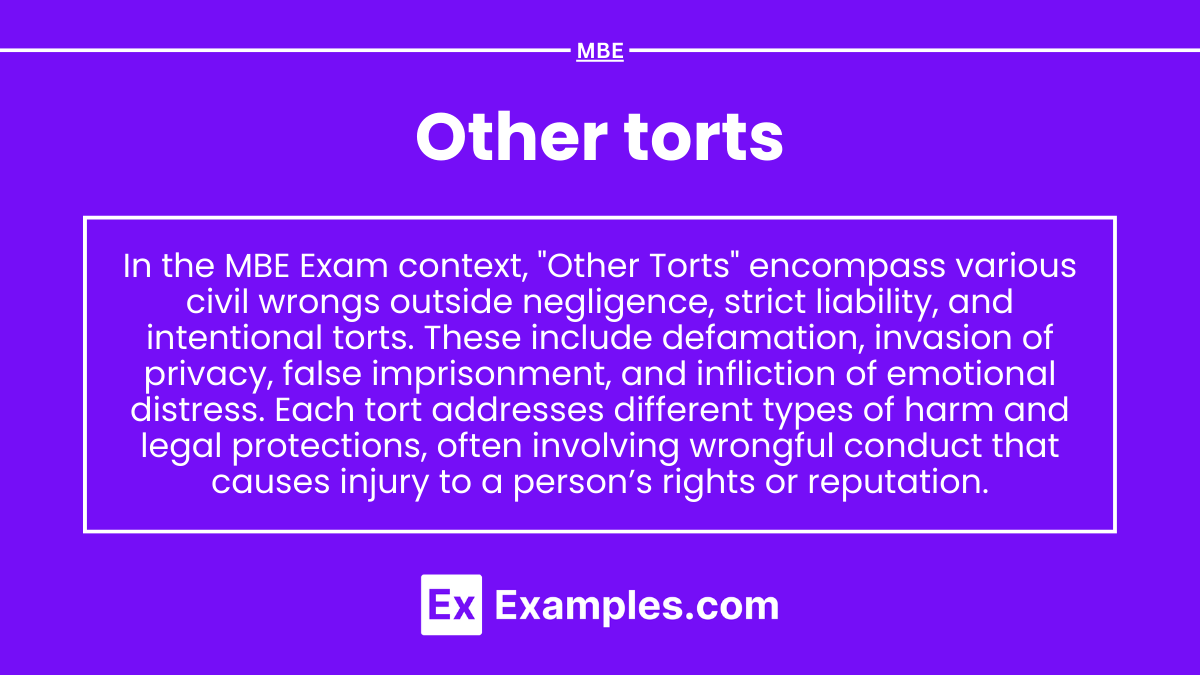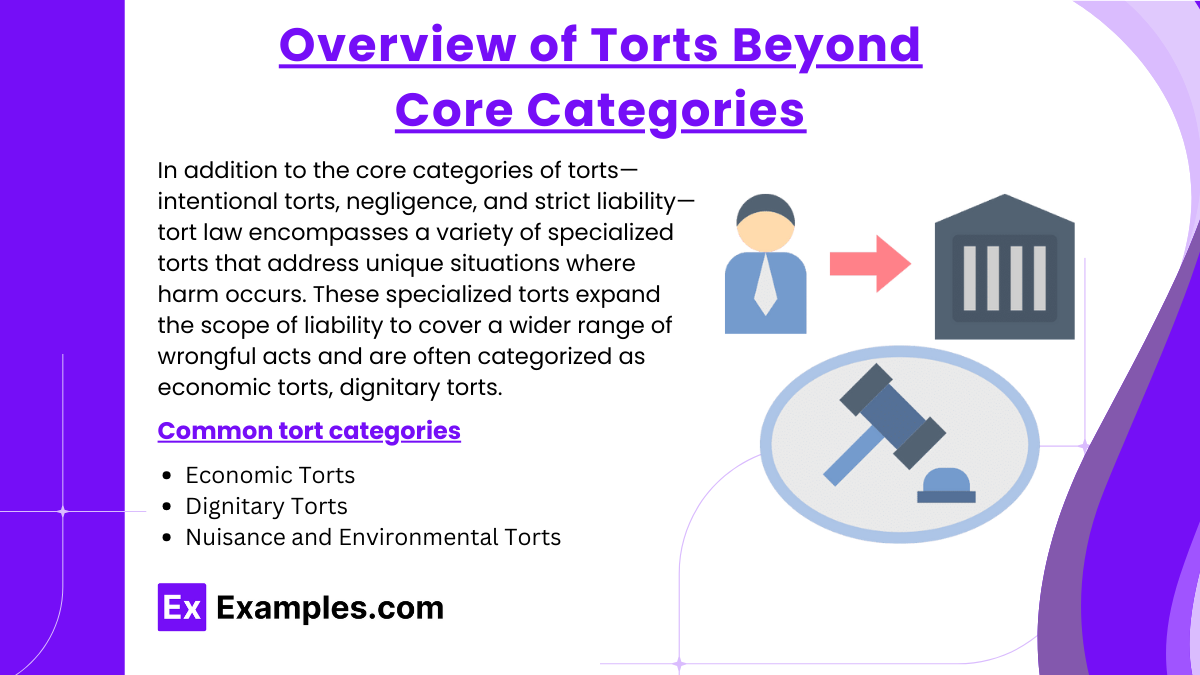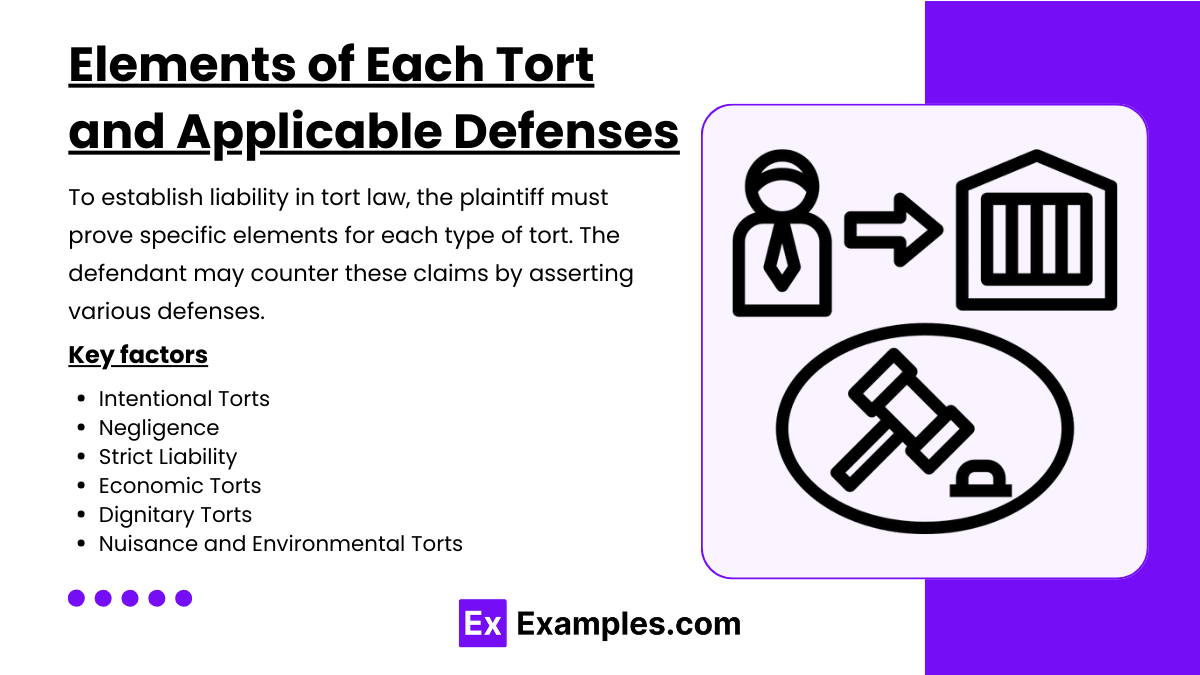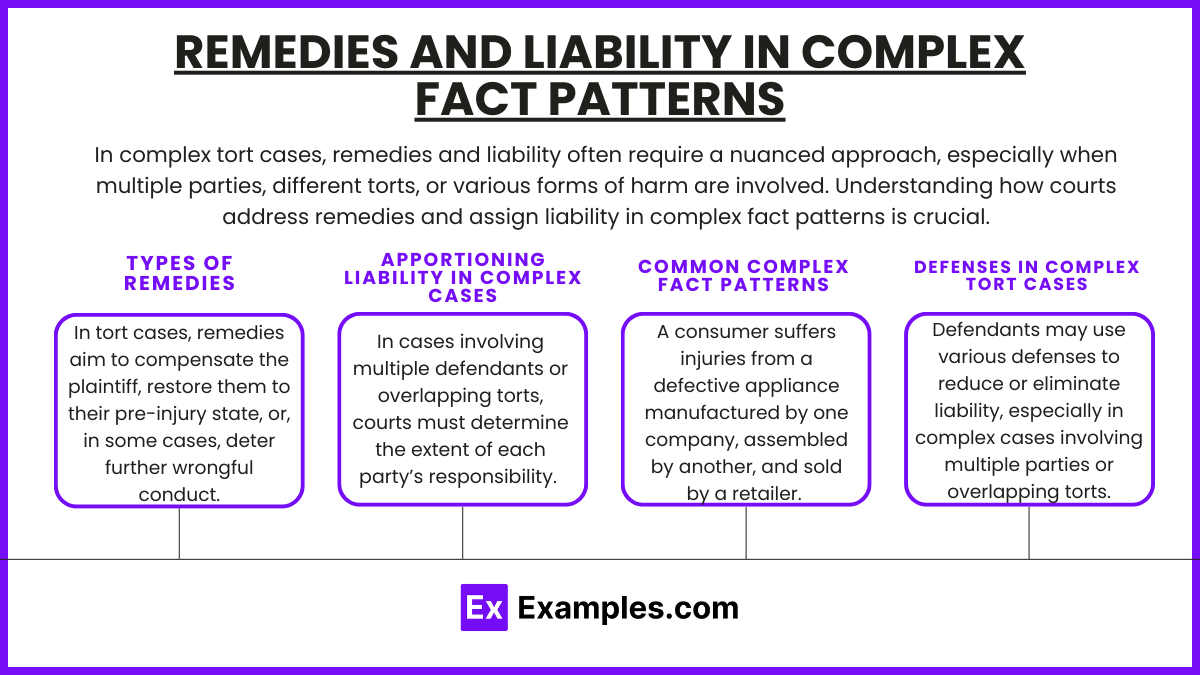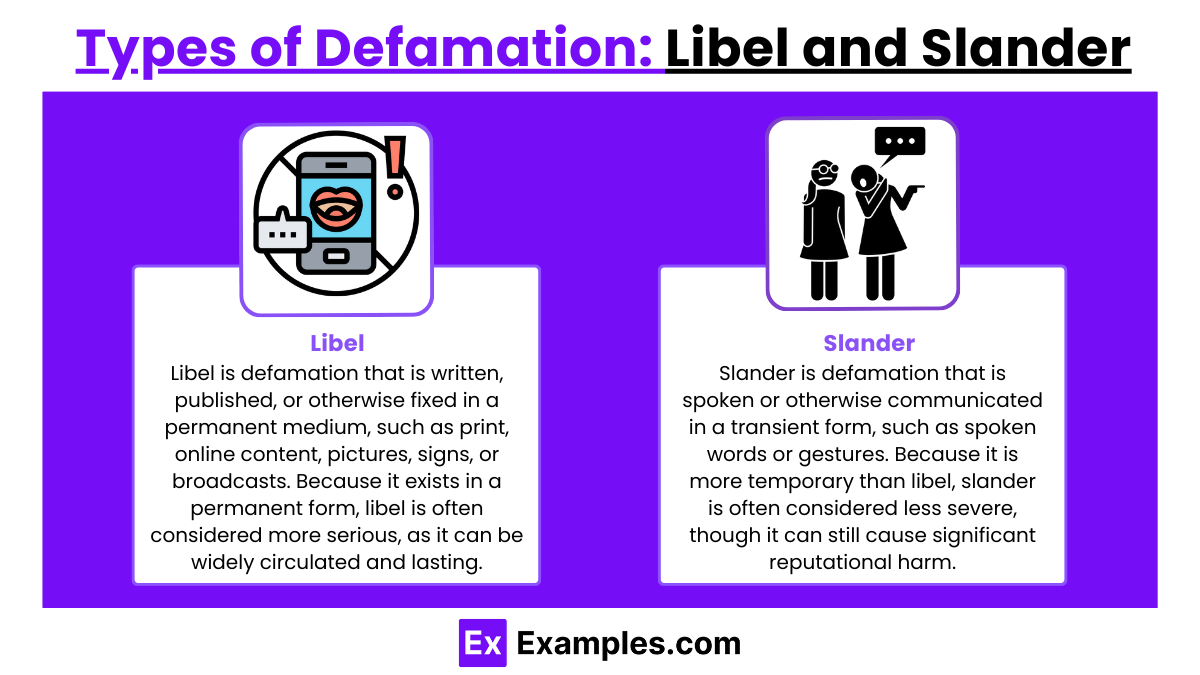Other Torts covers a range of civil wrongs that go beyond the basic principles of negligence, addressing specific actions that can result in liability. This topic includes intentional torts, such as assault, battery, false imprisonment, and defamation, as well as torts involving interference with property, like trespass and nuisance. Additionally, it explores complex areas like invasion of privacy, infliction of emotional distress, and interference with contractual relations. Understanding these torts is critical for identifying liability and applying legal principles to varied factual scenarios, as it broadens the scope of tort law beyond standard negligence cases.
Learning Objectives
In studying "Other Torts" for the MBE, you should learn to identify and understand various torts beyond the core categories of intentional torts, negligence, and strict liability. These include nuisance, defamation, invasion of privacy, misrepresentation, and economic torts like interference with contractual relations. Develop an understanding of the elements required to establish each tort, as well as the defenses that may be applicable. Analyze the distinctions between public and private nuisance, different types of defamation (libel and slander), and the various forms of invasion of privacy. Additionally, evaluate the remedies available for these torts and the potential for liability in complex fact patterns, which may involve multiple parties and overlapping claims. This foundational knowledge will prepare you to address nuanced questions on less common torts in the MBE.
Overview of Torts Beyond Core Categories
In addition to the core categories of torts—intentional torts, negligence, and strict liability—tort law encompasses a variety of specialized torts that address unique situations where harm occurs. These specialized torts expand the scope of liability to cover a wider range of wrongful acts and are often categorized as economic torts, dignitary torts, and nuisance and environmental torts. Here’s an overview of these less common tort categories:
1. Economic Torts
Economic torts focus on wrongful actions that cause financial or business-related harm rather than physical injury or property damage. These torts often apply in commercial contexts and are designed to protect individuals and businesses from unfair interference with their economic interests.
Types of Economic Torts:
Interference with Contractual Relations: This tort occurs when one party intentionally disrupts an existing contract between two other parties, causing economic harm. For example, if a competitor induces a business to break a contract with another company, this interference may constitute a tort.
Interference with Prospective Economic Advantage: Also known as "interference with business relations," this tort applies when someone disrupts a likely future business relationship, such as a prospective contract or partnership.
Fraud (or Deceit): Fraud involves intentionally misrepresenting a material fact to induce another party to act to their detriment. This tort is commonly used to seek damages for financial losses stemming from deceptive practices.
Conspiracy: Economic conspiracy occurs when two or more parties conspire to harm another party’s business interests through wrongful acts. This tort is often applied in cases involving anti-competitive behavior.
Example: A company that spreads false information about a competitor’s product quality to divert customers to its own product could be liable for interference with prospective economic advantage.
2. Dignitary Torts
Dignitary torts protect individuals from harm to their reputation, privacy, or personal integrity. These torts are often focused on non-physical harm and are particularly relevant in cases involving speech, publication, or personal boundaries.
Types of Dignitary Torts:
Defamation (Libel and Slander): Defamation involves making a false statement about someone that harms their reputation. Libel refers to written defamation, while slander refers to spoken defamation. Plaintiffs must typically show that the statement was false, damaging, and published to a third party.
Invasion of Privacy: This tort covers several privacy-related harms, such as intrusion upon seclusion (invasive surveillance or harassment), public disclosure of private facts (revealing private information), false light (spreading misleading information), and appropriation of likeness (using someone’s image without permission).
Intentional Infliction of Emotional Distress (IIED): IIED applies when a defendant’s extreme or outrageous conduct causes severe emotional distress to the plaintiff. The conduct must be more than rude or offensive; it must be shocking or intolerable to a reasonable person.
Malicious Prosecution and Abuse of Process: These torts protect individuals from wrongful use of legal proceedings. Malicious prosecution involves initiating a criminal or civil case with malice and without probable cause, while abuse of process occurs when legal proceedings are used for an improper purpose.
Example: If a news organization falsely reports that an individual committed a serious crime, this may constitute libel, allowing the individual to seek damages for reputational harm.
3. Nuisance and Environmental Torts
Nuisance and environmental torts address harm related to the use and enjoyment of land, as well as harm to the environment. These torts often involve property owners, businesses, and sometimes governments.
Types of Nuisance and Environmental Torts:
Private Nuisance: This tort occurs when someone’s use of their property unreasonably interferes with another person’s use and enjoyment of their own property. Examples include excessive noise, smoke, odors, or pollution emanating from a neighboring property.
Public Nuisance: Public nuisance involves an action that interferes with the rights of the general public. Unlike private nuisance, which affects specific individuals, public nuisance affects a community or large group of people, such as polluting a public waterway.
Trespass to Land: Trespass occurs when someone intentionally enters or causes something to enter another’s property without permission. While primarily a property tort, trespass may overlap with nuisance in cases where the trespass disrupts land use.
Environmental Torts: Environmental torts specifically address harm to the environment, such as air or water pollution, toxic spills, or contamination. These torts are often brought against companies engaged in manufacturing, waste disposal, or other potentially harmful activities.
Example: A factory that releases harmful chemicals into a nearby river may be held liable for public nuisance, as the pollution affects the entire community's access to clean water.
Elements of Each Tort and Applicable Defenses
To establish liability in tort law, the plaintiff must prove specific elements for each type of tort. The defendant may counter these claims by asserting various defenses. Here’s a detailed overview of the elements and defenses associated with each major category of tort, including intentional torts, negligence, strict liability, economic torts, dignitary torts, and nuisance/environmental torts.
1. Intentional Torts
Intentional torts occur when a person deliberately causes harm or offensive contact to another. Common intentional torts include battery, assault, false imprisonment, trespass, and intentional infliction of emotional distress (IIED).
Elements:
Battery: Intentional harmful or offensive contact with another person.
Assault: Intentional act that creates a reasonable apprehension of imminent harmful or offensive contact.
False Imprisonment: Intentional confinement of another person without legal authority or consent.
Trespass to Land: Intentional entry onto another person’s land without permission.
Intentional Infliction of Emotional Distress (IIED): Extreme or outrageous conduct intended to cause severe emotional distress.
Defenses:
Consent: The plaintiff agreed to the conduct, which bars recovery.
Self-Defense: The defendant used reasonable force to protect themselves from harm.
Defense of Others: The defendant acted to protect a third party from harm.
Defense of Property: The defendant used reasonable force to protect their property.
Privilege: The defendant had a legal right to engage in the act, such as a police officer making an arrest.
2. Negligence
Negligence occurs when a person fails to exercise reasonable care, resulting in harm to another. It is the most common basis for tort claims, especially in cases involving accidents or unintentional harm.
Elements:
Duty of Care: The defendant owed a duty to act as a reasonable person would under similar circumstances.
Breach of Duty: The defendant breached this duty by failing to act reasonably.
Causation:
Actual Cause: The harm would not have occurred “but for” the defendant’s conduct.
Proximate Cause: The harm was a foreseeable result of the defendant’s conduct.
Damages: The plaintiff suffered actual harm or injury as a result of the breach.
Defenses:
Contributory Negligence: In jurisdictions following contributory negligence, if the plaintiff is at all responsible for their harm, they may be barred from recovery.
Comparative Negligence: In comparative negligence systems, the plaintiff’s recovery may be reduced in proportion to their degree of fault.
Assumption of Risk: If the plaintiff knowingly and voluntarily engaged in a risky activity, they may be barred from recovery.
Statutory Immunity: Certain parties may have legal immunity from negligence claims, such as government entities under certain conditions.
3. Strict Liability
Strict liability applies when a defendant is held liable for harm caused by certain inherently dangerous activities or defective products, regardless of fault or intent.
Elements:
Abnormally Dangerous Activity or Defective Product: The defendant was engaged in a highly risky activity (e.g., using explosives) or produced a defective product (design, manufacturing, or warning defect).
Causation: The activity or defect caused the plaintiff’s injury.
Damages: The plaintiff suffered actual harm or injury.
Defenses:
Assumption of Risk: If the plaintiff knowingly and voluntarily encountered the risk, they may be barred from recovery.
Product Misuse: In product liability cases, the defendant may argue that the plaintiff misused the product in an unforeseeable manner.
Comparative Fault: Some jurisdictions apply comparative fault principles, which reduce the plaintiff’s recovery if they contributed to the harm.
Statutory Compliance: In some cases, compliance with regulations may provide a defense if the product or activity met all legal standards.
4. Economic Torts
Economic torts address wrongful interference with a person’s business, contracts, or other financial interests. Common economic torts include interference with contractual relations, fraud, interference with prospective economic advantage, and conspiracy.
Elements:
Interference with Contractual Relations:
Valid Contract: There was a valid contract between the plaintiff and a third party.
Knowledge of Contract: The defendant knew of the contract.
Intentional Interference: The defendant intentionally interfered, causing a breach.
Damages: The plaintiff suffered financial harm due to the interference.
Fraud (Deceit):
False Representation: The defendant made a false statement of material fact.
Knowledge of Falsity: The defendant knew the statement was false or acted with reckless disregard.
Intent to Induce: The defendant intended to induce the plaintiff to act.
Reliance and Damages: The plaintiff relied on the statement and suffered financial harm.
Defenses:
Justification or Privilege: The defendant may argue that their actions were justified or legally permissible, such as in lawful competition.
Truth (for Fraud): Truth is a defense to fraud, as a statement cannot be deceitful if it is true.
Lack of Causation: The defendant may argue that their actions did not directly cause the economic harm or contract breach.
5. Dignitary Torts
Dignitary torts protect a person’s reputation, privacy, and emotional integrity. They include defamation, invasion of privacy, intentional infliction of emotional distress (IIED), and malicious prosecution.
Elements:
Defamation (Libel and Slander):
False Statement: A false statement about the plaintiff was made.
Publication: The statement was communicated to a third party.
Harm: The statement caused harm to the plaintiff’s reputation.
Invasion of Privacy:
Intrusion upon Seclusion: Invasive conduct that breaches one’s privacy.
Public Disclosure of Private Facts: Sharing private information that would be highly offensive to a reasonable person.
Appropriation of Likeness: Using someone’s image or likeness without permission for gain.
IIED:
Extreme and Outrageous Conduct: The conduct was shocking or intolerable.
Intent: The conduct was intended to cause distress.
Severe Emotional Distress: The plaintiff suffered severe emotional harm.
Defenses:
Truth (Defamation): Truth is a defense to defamation since a statement cannot be defamatory if it is true.
Consent: The plaintiff consented to the conduct, especially in privacy cases.
Privilege (Defamation): In some cases, such as in court statements, absolute or qualified privilege may protect the defendant.
Lack of Intent (IIED): The defendant may argue that their actions were not intended to cause distress.
6. Nuisance and Environmental Torts
Nuisance and environmental torts address harm related to the use of land, property, and the environment. They include private nuisance, public nuisance, and trespass to land.
Elements:
Private Nuisance:
Substantial Interference: The interference is substantial and unreasonable.
Use and Enjoyment: The interference affects the plaintiff’s use and enjoyment of their property.
Public Nuisance:
Unreasonable Interference: The defendant’s conduct interferes with public rights or community interests.
Special Harm (if a private party sues): The plaintiff suffered harm distinct from that suffered by the general public.
Trespass to Land:
Intentional Entry: The defendant intentionally entered the plaintiff’s land without permission.
Defenses:
Consent (Trespass): The plaintiff consented to the defendant’s presence on the property.
Coming to the Nuisance: In private nuisance cases, if the plaintiff knowingly moved into an area with the nuisance, it may reduce recovery.
Statutory Compliance: If the defendant’s activity complied with regulations, it may be a defense in certain environmental torts.
Necessity (Trespass): If the trespass was necessary to prevent harm, the defense of necessity may apply.
Remedies and Liability in Complex Fact Patterns
In complex tort cases, remedies and liability often require a nuanced approach, especially when multiple parties, different torts, or various forms of harm are involved. Understanding how courts address remedies and assign liability in complex fact patterns is crucial, as it can affect how damages are awarded, who is held responsible, and which defenses may apply.
1. Types of Remedies
In tort cases, remedies aim to compensate the plaintiff, restore them to their pre-injury state, or, in some cases, deter further wrongful conduct. The three primary types of remedies include compensatory damages, punitive damages, and injunctive relief.
Compensatory Damages:
Economic Damages: These include quantifiable financial losses like medical bills, lost wages, property repair or replacement costs, and any other out-of-pocket expenses.
Non-Economic Damages: These cover non-quantifiable losses such as pain and suffering, emotional distress, loss of enjoyment of life, and loss of consortium.
Example: In a medical malpractice case involving a complex fact pattern, compensatory damages may include both the cost of corrective surgery and non-economic damages for the patient’s pain and suffering.
Punitive Damages:
These damages are awarded when the defendant's conduct is particularly reckless, malicious, or egregious. They are designed to punish and deter similar behavior rather than to compensate the plaintiff.
Example: In a complex product liability case where the manufacturer knowingly sold a defective product, punitive damages might be awarded to punish the company for its willful disregard for consumer safety.
Injunctive Relief:
This remedy is an order by the court requiring the defendant to do or refrain from doing something, often used when monetary damages alone cannot resolve the harm.
Example: In an environmental tort case involving ongoing pollution, the court may issue an injunction to stop the defendant from continuing harmful activities.
2. Apportioning Liability in Complex Cases
In cases involving multiple defendants or overlapping torts, courts must determine the extent of each party’s responsibility. Apportionment of liability can be complex, particularly when contributory factors vary in severity and impact.
Joint and Several Liability:
Under joint and several liability, each defendant can be held responsible for the full amount of damages. If one defendant cannot pay, the other defendants may be required to cover the entire amount.
Example: In a car accident involving multiple drivers whose negligence contributed to the crash, each driver might be jointly and severally liable for the total damages.
Comparative and Contributory Negligence:
Comparative Negligence: The plaintiff’s recovery is reduced in proportion to their degree of fault. In pure comparative negligence states, the plaintiff can recover even if they were mostly at fault. In modified comparative negligence states, the plaintiff can only recover if they are less than 50% (or in some states, 51%) at fault.
Contributory Negligence: In a few jurisdictions, if the plaintiff is even partially at fault, they are barred from recovery.
Example: In a slip-and-fall case where the property owner failed to clear ice but the plaintiff was distracted on their phone, the plaintiff’s recovery might be reduced based on their share of fault under comparative negligence.
Pro Rata Apportionment:
When liability is divided proportionally among defendants based on their contribution to the harm, each party is only responsible for their share.
Example: In a construction accident caused by both the contractor and equipment manufacturer, the court may apportion liability between them based on each party’s role in causing the harm.
3. Common Complex Fact Patterns
Product Liability with Multiple Defendants:
Scenario: A consumer suffers injuries from a defective appliance manufactured by one company, assembled by another, and sold by a retailer. The defect is traced to a faulty design by the manufacturer, but the assembler failed to include an essential safety component.
Liability: Courts may hold all three entities liable, as each had a role in bringing the defective product to market. Joint and several liability may apply, or the court may apportion liability based on each party’s contribution to the defect.
Remedies: Compensatory damages are likely awarded to cover medical expenses and lost wages. Punitive damages may also apply if the manufacturer knowingly sold a defective product.
Medical Malpractice with Multiple Healthcare Providers:
Scenario: A patient suffers severe complications following surgery due to the negligence of both the surgeon and the anesthesiologist.
Liability: Courts often apply joint and several liability to medical professionals in cases of shared responsibility. Each provider could be liable for the full amount, though some courts may apportion liability based on each provider’s role.
Remedies: Compensatory damages would likely cover the costs of additional medical treatment, loss of income, and non-economic damages for pain and suffering. Punitive damages might apply if there was gross negligence.
Environmental Tort Affecting Multiple Properties:
Scenario: A chemical factory leaks pollutants that contaminate groundwater, affecting several neighboring properties.
Liability: In environmental tort cases, the factory may be held strictly liable for contamination due to its hazardous activity. Courts may impose joint and several liability if multiple parties contributed to the pollution.
Remedies1–154: Injunctive relief may be ordered to prevent further contamination. Compensatory damages could cover property devaluation, cleanup costs, and health-related expenses. In cases of knowing or reckless pollution, punitive damages might also apply.
Defamation with Multiple Defendants:
Scenario: An individual’s reputation is harmed after a false statement is published in a newspaper, and multiple media outlets republish it.
Liability: Each party that publishes or republishes the defamatory statement can be held liable, as defamation laws generally consider each act of publication a separate offense. Joint and several liability may apply if all defendants contributed to the overall reputational harm.
Remedies: Compensatory damages may include reputational harm, emotional distress, and economic losses. Punitive damages could apply if the media outlets acted recklessly or with malice.
Public and Private Nuisance Affecting Both Private and Community Interests:
Scenario: A factory emits loud noise and pollution that disrupts a neighboring community’s daily life and specific homeowners’ property enjoyment.
Liability: The factory may face liability for both public nuisance (affecting the general community) and private nuisance (specific harm to property owners). Joint liability may apply if multiple entities own or operate the factory, and courts may apportion liability among them.
Remedies: Injunctive relief might be granted to stop the nuisance. Damages would compensate for lost property enjoyment and health effects. Punitive damages could apply if the factory knowingly disregarded pollution laws.
4. Defenses in Complex Tort Cases
Defendants may use various defenses to reduce or eliminate liability, especially in complex cases involving multiple parties or overlapping torts:
Comparative and Contributory Negligence: As discussed, defendants may argue that the plaintiff’s own negligence contributed to their injury, reducing their liability in comparative negligence cases or eliminating it in contributory negligence states.
Assumption of Risk: If the plaintiff knowingly and voluntarily assumed the risks associated with an activity, such as signing a waiver before participating in a potentially dangerous event, the defendant may avoid liability.
Act of God or Intervening Cause: In cases involving unforeseeable natural events or intervening acts by third parties, defendants may argue that these factors were the primary cause of harm, limiting their liability.
Statutory Compliance: Some defendants may argue that compliance with regulations or standards shields them from liability, especially in cases involving product or environmental liability.
Types of Defamation: Libel and Slander
Defamation is a tort that involves making false statements that harm another person's reputation. Defamation can take two primary forms: libel and slander. The distinction between these two types lies in the medium of the defamatory statement and, often, in the permanence of the statement. Here’s an in-depth look at libel and slander, including their definitions, elements, and distinctions.
1. Libel
Definition: Libel is defamation that is written, published, or otherwise fixed in a permanent medium, such as print, online content, pictures, signs, or broadcasts. Because it exists in a permanent form, libel is often considered more serious, as it can be widely circulated and lasting.
Examples of Libel:
A false newspaper article accusing someone of committing a crime.
A social media post or blog that wrongly claims a person engaged in unethical behavior.
A defamatory statement published in a book, magazine, or online review.
Elements of Libel:
False Statement: The statement must be false and defamatory, meaning it harms the individual’s reputation.
Published: The statement must be published or communicated to at least one third party, meaning it was accessible to others beyond the plaintiff.
Identification: The statement must be "of and concerning" the plaintiff, meaning it clearly identifies the plaintiff as the subject.
Harm: Libel generally presumes harm because of its permanent and often widespread nature; however, some cases may require proof of reputational damage or economic loss, especially if the plaintiff is a public figure.
Damages in Libel Cases:
Because libel is presumed to be more harmful due to its permanence, damages may be awarded without requiring the plaintiff to show specific harm (known as “presumed damages”). However, plaintiffs often seek compensatory damages for reputational harm and punitive damages if the libel was especially malicious.
Special Case - Libel Per Se:
In some jurisdictions, libel per se applies when the defamatory statement is so inherently damaging (such as falsely accusing someone of a crime) that harm to the plaintiff’s reputation is presumed, without requiring specific proof of harm.
2. Slander
Definition: Slander is defamation that is spoken or otherwise communicated in a transient form, such as spoken words or gestures. Because it is more temporary than libel, slander is often considered less severe, though it can still cause significant reputational harm.
Examples of Slander:
A false statement made verbally during a public event accusing someone of unethical conduct.
Spreading a false rumor about someone’s personal or professional life during a conversation.
A defamatory remark made in a speech or broadcast, which is not recorded or transcribed.
Elements of Slander:
False Statement: Like libel, the statement must be false and defamatory.
Published: The statement must be communicated to at least one third party, beyond the plaintiff.
Identification: The plaintiff must be identifiable in the statement.
Special Damages (in most cases): Because slander is considered less permanent, the plaintiff must usually prove specific damages, such as lost income, job opportunities, or economic losses resulting from the statement.
Damages in Slander Cases:
Slander typically requires the plaintiff to show special damages (actual losses or harm) unless the statement falls into a category called slander per se (discussed below).
Special Case - Slander Per Se:
In slander per se cases, harm to the plaintiff’s reputation is presumed, eliminating the need to prove special damages. Common categories for slander per se include false statements that:
Accuse someone of committing a crime.
Suggest a person has a contagious or loathsome disease.
Imply that someone is professionally incompetent or unethical.
Impugn the chastity of a woman (though this is less common in modern defamation law).
Examples
Example 1: Defamation
Defamation occurs when a false statement is made about someone that damages their reputation. This can happen in both written form (libel) and spoken form (slander). For instance, if an individual falsely accuses someone of committing a crime in a public setting, that person may sue for defamation to recover damages for harm caused to their reputation.
Example 2: Trespass to Land
Trespass to land occurs when someone enters or remains on another person’s property without permission. For example, if a person walks onto someone else's private property without consent or refuses to leave after being asked, they may be held liable for trespass. This tort protects an individual's right to the exclusive use of their property.
Example 3: False Imprisonment
False imprisonment happens when a person is intentionally confined or restrained against their will. This can occur in various situations, such as when a shopkeeper detains a customer without cause for suspicion of shoplifting. False imprisonment can be physical, such as being locked in a room, or by other means, like being forced to stay in a place without consent.
Example 4: Intentional Infliction of Emotional Distress (IIED)
IIED is a tort that involves extreme or outrageous conduct that causes severe emotional distress to another person. An example might be a person continuously harassing or threatening another in a manner that causes them significant psychological harm. This tort allows individuals to seek compensation for emotional injury caused by another’s intentional actions.
Example 5: Conversion
Conversion is the wrongful taking or control of someone else's personal property without their permission, essentially depriving them of their property rights. For example, if a person borrows an item but refuses to return it, or sells someone else's belongings without consent, they may be liable for conversion. This tort ensures that individuals maintain control over their own possessions.
Practice Questions
Question 1
Which of the following is an example of defamation?
A) A person accidentally damages another's car in a parking lot.
B) A person makes a false statement about someone, causing harm to their reputation.
C) A person enters someone’s property without permission but does no damage.
D) A person uses another’s property without consent and returns it undamaged.
Correct Answer: B) A person makes a false statement about someone, causing harm to their reputation.
Explanation: Defamation is the act of making false and damaging statements about someone. It can be in the form of slander (spoken) or libel (written). Option B clearly describes this scenario. Option A refers to negligence or property damage, while C and D describe trespass and conversion, respectively, which are different torts.
Question 2
Which of the following would likely constitute false imprisonment?
A) A person refuses to leave a public place after being asked.
B) A person is confined in a room without the ability to leave, without consent or legal authority.
C) A person is detained by security for questioning but is allowed to leave after a few minutes.
D) A person’s car is accidentally locked in a parking lot.
Correct Answer: B) A person is confined in a room without the ability to leave, without consent or legal authority.
Explanation: False imprisonment occurs when a person is intentionally confined without legal justification or consent. In option B, the person is restrained in a room against their will, which constitutes false imprisonment. Option A may involve minor confinement but does not meet the legal threshold for false imprisonment. Options C and D are not examples of false imprisonment, as the person is either not confined for a long period or the confinement is unintentional.
Question 3
What is the main element that must be proven in a claim for conversion?
A) That the defendant intended to cause harm to the plaintiff.
B) That the defendant had control over the plaintiff's property without permission.
C) That the defendant made a false statement to damage the plaintiff's reputation.
D) That the defendant physically harmed the plaintiff.
Correct Answer: B) That the defendant had control over the plaintiff's property without permission.
Explanation: Conversion is the wrongful act of taking or controlling someone else’s property without consent, essentially treating the property as one's own. Option B correctly identifies the core element of conversion. Options A, C, and D describe other torts (e.g., battery for harm, defamation for false statements), not the elements of conversion.

